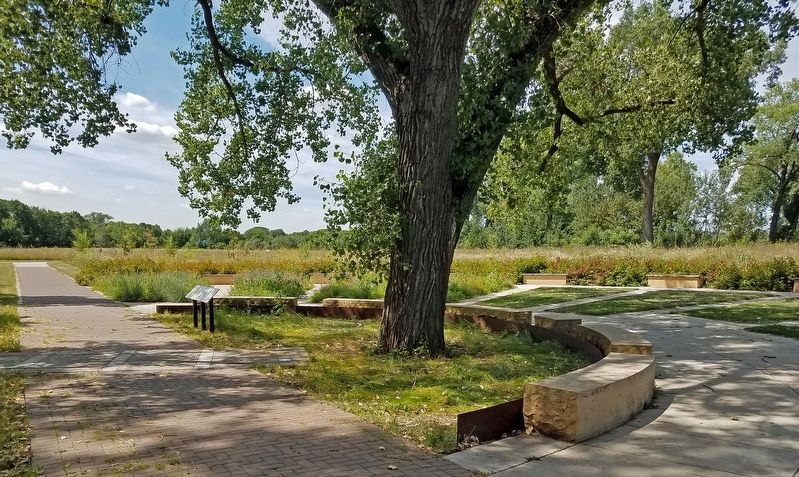Maplewood in Ramsey County, Minnesota — The American Midwest (Upper Plains)
Building the "Skally"
Round and Round They Go
A roundhouse, or engine house, is named for its distinctive shape and used for repairing and storing locomotives. Turntables allowed for efficient engine re-direction and movement. Completed in 1888 the Gladstone Shops roundhouse had 25 stalls.
Archaeologists found evidence of roundhouse maintenance pits and confirmed the turntable had been removed after work was relocated to other repair shops by 1915.
Gladstone Savanna was once a thriving railroad maintenance yard. A railroad connecting St. Paul and Duluth was envisioned in 1857 but financial panics and the Civil War delayed sustained construction efforts until the late 1860s. At thirty-five minutes past 11 o'clock pm, on August 1, 1870 the first train operated by the Lake Superior & Mississippi Railroad (LS&M) arrived in Duluth.
The railroad cut days off the journey, shifted commerce from the Mississippi RIver to Lake Superior, and helped make Duluth the fasted growing city in the nation. For years the line was known as the "Skally," a nickname variously attributed to Irish, Italian, and Swedish immigrants.
In 1877 financial difficulties saw the railroad reorganized into the St. Paul & Duluth Railroad. The StP&D operated for 23 years and had a fleet of over 2,500 locomotives and cars, many built here at the Gladstone Shops. The company was purchased and incorporated into the Northern Pacific Railway in 1900 and ultimately into the Burlington Northern Railway system until the tracks were discontinued in 1987.
Why Gladstone?
Competition and new StP&D Board membership in June 1887 ushered in an era of expansion, including building new maintenance shops. This was the first level area north of St. Paul along the rail line and already had a depot. Moreover, the StP&D was given 30 bonus acres. Gladstone founder, William Dawson, clearly realized the Shops' potential to improve local prosperity. Construction began in August and Gladstone was platted weeks later.
Caption:
Railroads were Minnesota's transportation lifeblood in the 19th century and the Gladstone Shops maintained the engines and cars that used these arteries. Pictured above is Engine 69 which saved hundreds of lives during the Great Hinckley Fire of 1894 and was afterwards repaired here.
Caption:
The Gladstone Depot, once located just two blocks northeast of where you are now.
Railroad Jobs
The Gladstone shops employed more than 100 men. Look at the 1900 census for this township and you find over a dozen Gladstone Shops occupations. Often listed ahead of the job (blacksmith or fireman) was "R.R.," but there were also painters, car repairers, molders, boiler workers, and coal heavers. Along with these were associated railroad jobs such as station agents, engineers, and telegraph operators.
Banning and Cooke
Many people made the St. Paul to Duluth line possible including two names you probably already know: William Banning and Jay Cooke.
In 1864 Philadelphia native William Banning became LS&M president and was instrumental in its success by enticing Philadelphia banker Jay Cooke to invest. The capital of early investors secured the Duluth route.
Today Banning and Cooke are memorialized along the route by state parks bearing their names.
Erected by City of Maplewood.
Topics. This historical marker is listed in these topic lists: Industry & Commerce • Railroads & Streetcars. A significant historical date for this entry is August 1, 1870.
Location. 44° 59.92′ N, 93° 2.79′ W. Marker is in Maplewood, Minnesota, in Ramsey County. Marker can be reached from the intersection of Frost Avenue and English Street. Marker is near the northeast entrance to Gladstone Savanna. There is street parking along Frost Avenue. Touch for map. Marker is in this post office area: Saint Paul MN 55109, United States of America. Touch for directions.
Other nearby markers. At least 8 other markers are within walking distance of this marker. Gladstone Savanna's Natural History (about 300 feet away, measured in a direct line); History in Depth (about 400 feet away); Water: A Well Needed Resource (about 400 feet away); A History of Change (about 500 feet away); The Shops at Gladstone (about 500 feet away); Destination Lake Phalen (approx. 0.7 miles away); Phalen Regional Park Waterfall (approx. ¾ mile away); Frost Avenue (approx. ¾ mile away). Touch for a list and map of all markers in Maplewood.
Credits. This page was last revised on August 12, 2019. It was originally submitted on August 11, 2019, by McGhiever of Minneapolis, Minnesota. This page has been viewed 481 times since then and 48 times this year. Photos: 1, 2. submitted on August 11, 2019, by McGhiever of Minneapolis, Minnesota. • Bill Pfingsten was the editor who published this page.

